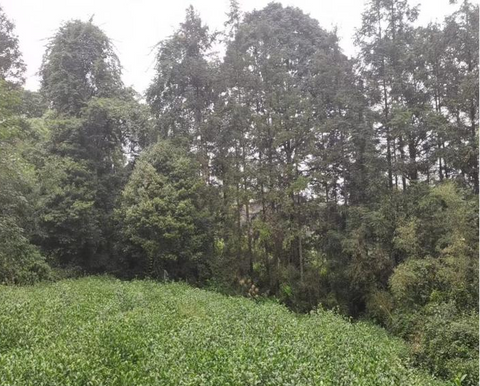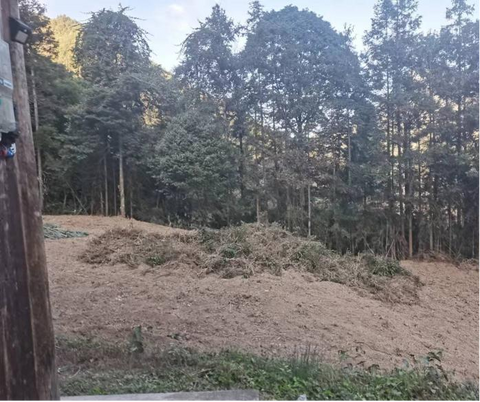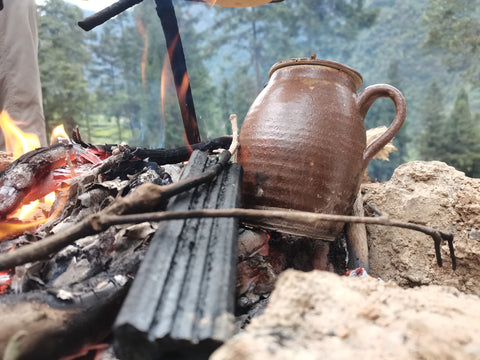Manyingtai 2024: Cooperative Mingqian Picking & Tea Jar Brewing
Organic Or Oblivion?
We have begun our biggest and most decisive push to protect traditional tea production in Manyingtai Village. On February 4th, Manyingtai sub-village leader Wang Changshan called together the ten remaining village households for the year-end meeting. By his estimate, at the end of 2023, the ten households that are still engaged in tea production have seen the total area of tea cultivation reduced from 50 acres to some 8 acres of conventional tea fields and 3 acres of wild bushes. The rest have been cleared out in a private-public project to get the village ready for eco-tourism. The provincial government, with the support of a few local corporations, wants to see the establishment of a tourist resort, a TikTok livestream space, and and an industrial fiber factory in the village within the next two years. Already, new paved roads and street lamps now connect the mountain hamlet with the county street at the base of the mountain. The immediate future of tea production and village life has now become uncertain.


(July 2023) (January 2024)
Shaken, but not broken by these developments, we proposed a plan to Wang Changshan that the ten remaining tea farming households have all endorsed. In the weeks leading up to the first pick, Changshan supervised the village fields and made sure that no one applied chemical fertilizer or burned trash. We then personally oversaw the collection of all tea by the cooperative between March 22nd and the Qingming Festival, and paid for it in cash daily. Volunteers Jose and Nathan joined us in picking at our own plot and other hard-to-reach plots. They helped aging farmers of the Wang Changquan household close the gap between themselves and younger pickers. The tea picked by ourselves, volunteers, and member households all were used to make either Cuizhen or Maojian, depending on the cultivar. Hopefully, come July, we will have sold all of this tea and demonstrated the viability of organic tea production, even if there is an immediate reduction in yield. This July, farming households will get dividends based on the share of the tea they picked, as shown below:
| Household | Yield Value (RMB) | Yield Share | Yield Weight (JIn) |
| Member Households | |||
| Wang Changquan | 1003.00 | 5.62% | 27.3 |
| Wang Qingjian | 1539.00 | 8.63% | 28.7 |
| Wang Qingjia | 719.60 | 4.03% | 43.9 |
| Wang Yulin | 1605.40 | 9.00% | 53.4 |
| Wang Qingxue | 3847.00 | 21.57% | 81.4 |
| Wang Changjiang | 2850.00 | 15.98% | 65.5 |
| Wang Changshan | 2599.00 | 14.57% | 56.8 |
| Bian Xinyuan | 502.00 | 2.81% | 8.4 |
| Wang Qinggao | 3173.00 | 17.79% | 71.8 |
| Wang Qingbing | 1874.00 | 10.51% | 40.3 |
| Non-Member Households | |||
| Wang Xiuying | 32.9 | ||
| Total | 17838 | 510.4 |
The actual experience of being the point of contact between the tea farming households and the cooperative factory we work with, Loushuiyuan, was one of the most difficult and eye-opening experiences we have had so far in the Chinese tea world. A short Mingqian picking season was cut even shorter by low temperatures, frequent rain, and the slower growth that the lack of fertilizer application necessitates. Since the market price for perfectly picked fresh leaves dropped from 70 RMB to just 15 RMB per Jin in the course of two weeks, disputes between cooperatives members and the factory sprung up daily. Two households tried to sneak in non-organic, outside tea and sell it to the cooperative at the inflated rate designed to encourage organic production; farmers wanted to pick on rainy days while the cooperative factory did so only after much protest, not wanting to deal with the low-quality product that rain soaked leaves generate. The very idea of a "market price" broke down when the only reference points are the bridge-side farmgate market and the three or four local wholesalers who work together to push the prices down to whatever minimum allows a farmer to make the equivalent of a day wage, about 150 RMB / day.
Tea Jar Brewing
To help promote the cooperative's tea. We sought out the help of local ceramic producer Liu Hailong to help us recreate the tea jars (茶罐) that were historically used to enjoy green tea in the area. The tea jars in question actually long predate green tea, which at best only joined the local diet just four centuries ago. Lu Yu himself makes passing reference to an exotic form of tea preparation “between Ba (Sichuan) and Jing(Western Hubei),” where tea would be first heated over fire then infused in a ceramic vessel, often with ginger, mandarins, and scallions. Today, a 1000+ years after Lu Yu's time, a similar habit of pre-cooking tea leaves in an earthenware vessel before an extended boiling survives in some Miao and Tujia areas of Hubei, Chongqing, Hunan, and Sichuan. It survives also among the Lahu people in Yunnan and the Shan people in Burma. Although tea jar and tea jar adjacent pots have recently started to catch on at high-end tea venues in China, the idea of using them to pre-cook and boil green tea, as was traditionally done here in Enshi, is still beyond the pale for most Chinese tea enthusiasts.


Traditionally, the earthenware jars are placed next to the fire on slow burning coals and allowed to heat up. The same effect can be achieved with some electric tea-pot burners, though one may have to use the highest setting to get the heat to properly permeate through the jar. Regardless of how one gets it hot, once you think it is hot enough, drop a tiny splash of water in to make sure. If the water hisses and turns to steam, you are ready to drop in your green tea. Once in the jar, the tea leaves should be shaken vertically to make sure they pre-cook evenly on the bottom on the jar. A shorther, 10-20 second pre-cooking will ensure an extra potent brew, while long durations that darken and even char the leaves make for lighter, roastier flavors. After pre-cooking to taste, boiling hot water is added to the jar, the lid goes on, and the tea is allowed to boil. In past generations, the tea would be re-heated in the jar over the coals through the day or even over the course of several days until all the flavor has been boiled out.
Practically speaking, green tea could be pre-cooked and boiled in any tea pot over a sufficient heat source. It is a matter of historical speculation why grandpa-brewing, now usually done in glassware, has won out over the tea jars that only a century ago still covered a massive portion of southwestern China. As a brewing method, tea jar style certainly does offer colors, aromas, and flavors not possible with Chinese green tea. It is perhaps the best way to enjoy green tea if you are not a green tea enjoy.